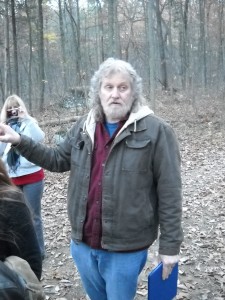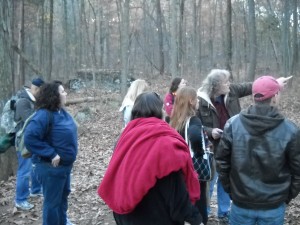At a recent TAG (Theoretical Archaeology Group) Conference in which I spoke at the University of California, Berkeley (May 2011), one session explored “the spatial, temporal, human, and non-human dimensions of movement in the patterning, timing, and causation of co-presence of various pasts in its materializing traces”. This session topic is quite similar to what I do in a “ghost excavation”. In a “ghost excavation”, movement and action are critical to generating interactive past cultural presence in all its materializing sensory trace elements. This movement as a controlled, sequential investigative field action is especially significant, I propose, on haunted Civil War battlefields. In these landscape settings, I control movement and action using the K.O.C.O.A (Key areas, Observation areas, Cover and Concealment areas, Obstacle Areas, and Avenues of Approach) as a baseline frame for “excavation”. K.O.C.O.A. is the military terrain strategy that was used during the Civil War by both Union and Confederate military commanders. Within the excavation frame, the investigation team follows I.M.P. (Inherent Military Probability) behavior in these K.O.C.O.A. spaces. I.M.P. behavior is what the soldier would have done in particular K.O.C.O.A. spaces and in specific military situations. The purpose of a “ghost excavation” is to structure practice and interaction (“the unearthing” of I.M.P. behavior) with past presence through a comprehensive ethnography of communication (EOC). This is quite different than a ghost hunter’s EVP “command and demand” sessions as they move about a haunted location.
In a ghost excavation, I am concerned with attending to both investigative and materializing movements, and the way in which relations (an ethnographic participant observation) define the sets of conditions and situations (cultural scenarios). I explore the ways that these scenarios (as cultural movements of interaction) continue to facilitate a sense of community, and are still maintained, through resonating cultural practices, even after physical death. The particular case study of the 15th Alabama as an integrated community, with a particular I.M.P., is investigated. The “ghost excavator” reveals those elements of the 15th Alabama that continue to execute particular movements and specific actions (as I.M.P. cultural behaviors), despite displacements in time (past/present), place (Alabama/Gettysburg), and being (alive/dead). The immediate “field reveals” and post-excavation analysis of the “ghost excavation” in the woods where the 15th Alabama fought at Little Round Top shows that manifestations did occur relative to the movements and actions that weave through space. Furthermore, these manifestations increased as continued actions become more resonating with respect to past actions in specific spaces. These findings indicate that these haunted battlefield spaces do comprise haunting elements that defy simple characterizations. The degree, intensity, amount, and duration, I would argue, of these haunting manifestations is dependent upon our contextual and resonating movements (in cultural scenarios) through the K.O.C.O.A. spaces, not the simple use of a tech sweep that merely measures ambient space.
It is ironic (and unethical) that sites that were once locations of toil, suffering, exertion, struggle, and death are now almost always approached as areas of leisure, reflection, and “ghost hunting”! My “ghost excavations” of the 15th Alabama (and specifically Company G, a “band of brothers”) and their terrible engagement with the 20th Maine at Little Round Top is meant to change that perspective. A “ghost excavation” moves away from more sedate (“watch and wait”) non-contextual actions and movements (tech scans). During a “ghost excavation”, I choose instead to explore the participatory acts of I.M.P. movements through the woods of the 15th Alabama engagement. The “ghost excavation” is a resonating performance through and in the archaeological complex of the “killing fields” (and cover and concealed spaces) of the 15th Alabama in those deadly woods on the eastern slopes of Little Round Top.
The use of an ethnographic display as a peripatetic video (among other mediations) will be installed in the woods at a later date for the benefit of those interactive presences that continue to linger there. The peripatetic video is a form of located media which exhibits previous performances (our ‘ghost excavation’ acts and movements), experiences, and events that occurred in the woods at Little Round Top, during and after the battle. This is a layered mediation. It will show:
- The “ghost excavation” (video, EOC, personal comments and experiences, etc.);
- Historical narratives with contemporary perceptions and the contemporary sense of this place;
- Video playback of the movie, “Gettysburg with scenes from the 15th Alabama/20th Maine, engagement; and,
- Scenes of the engagement at Little Round Top from Ken Burns documentary, The Civil War.
All of these mediations will be exhibited in the same space, as part of the symmetry of time and space at this haunted site. In addition, photographs taken during these excavations, and EVP clips recorded there, will also be presented. The excavation team will record the manifesting results of this ethnographic installation. This installation, video, photography, performance, and the field report ‘reveals’ is a form of contemporary archaeological investigation (“an archaeology in and of the present”) that is meant to unearth a more complete representation of cultural reality at a site of Civil War combat. This is the 2nd life of a haunting…
“You can think of life after death as a second life which you enter into as a portrait or inscription, and in which you remain longer than you do in your actual living life.”
- Susan Hiller, Artist and Anthropologist
Is this “second life” recordable? If so, what can we expect to manifest? Can a “script” and an actor, written by a cultural anthropologist, resonate with any lingering ‘ghost soldiers’ on a perceived (and publically-imagined) haunted battlefield? Can a film that depicts that battle (however inaccurate it is) evoke memories from that battle? Are photographs and sounds taken in those fields and woods of engagement the reality of 1863? Is a ‘ghost excavation’ a viable mediation of that past and does it manifest contemporary cultural reality? Do these aspects of mediating a story for a contemporary ‘dead’ audience have repeatable past performances? What follows is the beginning of what can be called the ‘haunting archaeologies’ of unearthing the continuing living “remains” of the 15th Alabama as they remain engaged at Little Round Top in Gettysburg.



